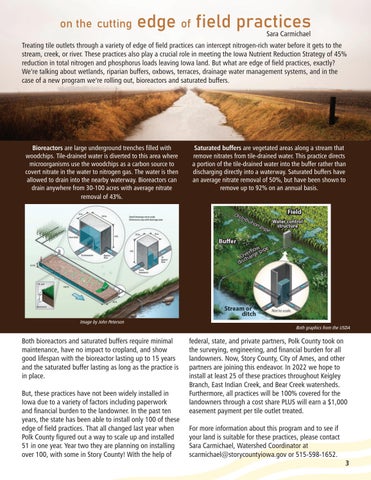on the cutting
edge of field practices Sara Carmichael
Treating tile outlets through a variety of edge of field practices can intercept nitrogen-rich water before it gets to the stream, creek, or river. These practices also play a crucial role in meeting the Iowa Nutrient Reduction Strategy of 45% reduction in total nitrogen and phosphorus loads leaving Iowa land. But what are edge of field practices, exactly? We’re talking about wetlands, riparian buffers, oxbows, terraces, drainage water management systems, and in the case of a new program we’re rolling out, bioreactors and saturated buffers.
Bioreactors are large underground trenches filled with woodchips. Tile-drained water is diverted to this area where microorganisms use the woodchips as a carbon source to covert nitrate in the water to nitrogen gas. The water is then allowed to drain into the nearby waterway. Bioreactors can drain anywhere from 30-100 acres with average nitrate removal of 43%.
Image by John Peterson
Both bioreactors and saturated buffers require minimal maintenance, have no impact to cropland, and show good lifespan with the bioreactor lasting up to 15 years and the saturated buffer lasting as long as the practice is in place. But, these practices have not been widely installed in Iowa due to a variety of factors including paperwork and financial burden to the landowner. In the past ten years, the state has been able to install only 100 of these edge of field practices. That all changed last year when Polk County figured out a way to scale up and installed 51 in one year. Year two they are planning on installing over 100, with some in Story County! With the help of
Saturated buffers are vegetated areas along a stream that remove nitrates from tile-drained water. This practice directs a portion of the tile-drained water into the buffer rather than discharging directly into a waterway. Saturated buffers have an average nitrate removal of 50%, but have been shown to remove up to 92% on an annual basis.
Both graphics from the USDA
federal, state, and private partners, Polk County took on the surveying, engineering, and financial burden for all landowners. Now, Story County, City of Ames, and other partners are joining this endeavor. In 2022 we hope to install at least 25 of these practices throughout Keigley Branch, East Indian Creek, and Bear Creek watersheds. Furthermore, all practices will be 100% covered for the landowners through a cost share PLUS will earn a $1,000 easement payment per tile outlet treated. For more information about this program and to see if your land is suitable for these practices, please contact Sara Carmichael, Watershed Coordinator at scarmichael@storycountyiowa.gov or 515-598-1652.
3




